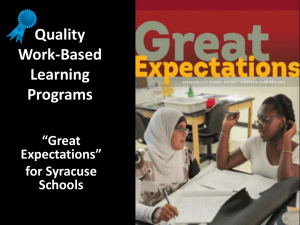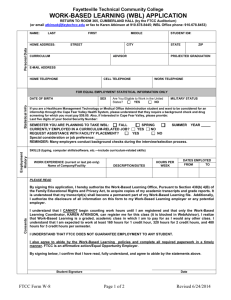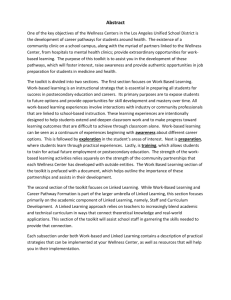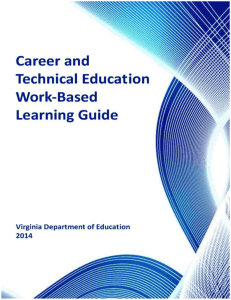Youth Transition Action Team California ILP Institute
advertisement
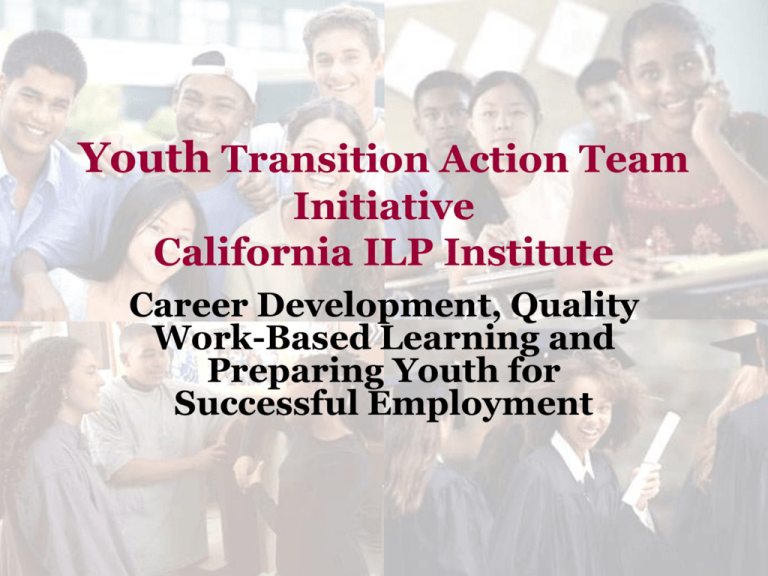
Youth Transition Action Team Initiative California ILP Institute Career Development, Quality Work-Based Learning and Preparing Youth for Successful Employment New Ways to Work, Youth Transition Action Team Initiative April 22, 2008 New Ways to Work Builds community connections that prepare youth for success • 25 years building comprehensive youth-serving systems nationally • Focuses on effectively targeting public resources to prepare youth for the future • Connects efforts to Economic Development • Pioneered the All Youth-One System approach New Ways to Work, Youth Transition Action Team Initiative April 22, 2008 New Ways to Work Where New Ways Works • Supporting connections between schools, community, and the workplace across the nation • Building connected transition systems for all youth in California • Building community capacity through customized technical assistance locally New Ways to Work, Youth Transition Action Team Initiative April 22, 2008 New Ways to Work Outcomes • • • • • High School Completion College and Career Success Reconnection and Transition Prepared Workforce Connected Communities New Ways to Work, Youth Transition Action Team Initiative April 22, 2008 New Ways to Work Program Strategies • • • • • • • High School Improvement/Alternatives Multiple Pathways/CTE Career Development Workplace Connections and Community Partnerships Quality Work-based Learning Out-of-School Time Programs Transition Centers New Ways to Work, Youth Transition Action Team Initiative April 22, 2008 Pathway to Adulthood • What activities and opportunities helped you prepare for a successful career? New Ways to Work, Youth Transition Action Team Initiative April 22, 2008 New Ways to Work, Youth Transition Action Team Initiative April 22, 2008 ILP Enhancement Vision shift Move from a classroom-based service delivery system to a system focused on preparing youth for transition through career development and employment readiness. New Ways to Work, Youth Transition Action Team Initiative April 22, 2008 Role of ILP System Connections • • • • Employers and workplace partners Families and neighborhoods Schools and training organizations Social services and community organizations New Ways to Work, Youth Transition Action Team Initiative April 22, 2008 Quality Work-based Learning Activities that occur at a workplace, providing structured learning experiences for students through exposure to a range of occupations. Students learn by observing and/or actually doing real work. Learning in the workplace is connected to and supports learning in the classroom. Work-based learning activities promote the development of broad, transferable skills. New Ways to Work, Youth Transition Action Team Initiative April 22, 2008 Why WBL? Students who gain exposure to the workplace while still in school: • Make connections between real work expectations and the classroom; • Begin to pursue education with a greater sense of purpose; • Interact with positive adult role models; • Develop new skills and knowledge; • Experience enhanced self esteem; and • Expand their horizons and awareness of future work options. New Ways to Work, Youth Transition Action Team Initiative April 22, 2008 New Ways to Work, Youth Transition Action Team Initiative April 22, 2008 Examples of taking work-based learning to the next level Quality WBL Traditional WBL Foster youth and adult relationships Young people work as individuals, completing tasks that require little interaction with supervisor. Young people work on teams as well as on an individual basis, and work on complex activities that allow for regular coaching and mentoring from their supervisor and colleagues. Support academic learning Classroom and work-site learning are disconnected from one another. Learning opportunities between classroom and worksite are unrelated. Students’ academic learning drives work-based learning objectives. Experiences are designed to make connections between worksite and curriculum themes. Individualized work-based learning plans All students are expected to master the same tasks and skills. Individualized work-based learning plans are developed for each student. Quality documentation and evaluation Students’ workplace experience is known only to the student and worksite supervisor. Students’ workplace experience documentation and evaluations are part of the school portfolio. Seven Simple Guidelines 1. 2. 3. 4. 5. 6. 7. Plan and prepare for successful experiences Maximize learning Provide effective supervision Promote safety Manage the hours a student is at the worksite Pay when required Provide ongoing support New Ways to Work, Youth Transition Action Team Initiative April 22, 2008 Guideline 2: Maximize Learning • • • • • Expose students to all aspects of the industry. Make ties to the classroom. Involve students in setting expectations. Provide opportunities for reflection. Document and measure learning. New Ways to Work, Youth Transition Action Team Initiative April 22, 2008 Guideline 2: Maximize Learning The 3 Key Elements to Learning: Intention Opportunity Reflection New Ways to Work, Youth Transition Action Team Initiative April 22, 2008 Guideline 2: Maximize Learning Intention: Awareness prior to the experience of the knowledge and skills one intends to acquire. All set intentions together: Employer Teacher Student New Ways to Work, Youth Transition Action Team Initiative April 22, 2008 Intention Work-Based Learning Skills Checklist serves client / customer teaches others works well as a team member exercises leadership knows how to negotiate Employer SCANS Tool New Ways to Work, Youth Transition Action Team Initiative April 22, 2008 PERSONAL SCANS SKILLS ASSESSMENT This assessment lists the individual skills and talents that employers value. Read the list and assess your own strengths. Mark each box that best describes your level of skill. Skills for Basic Job Performance (1=lowest; 5=highest) 1 SKILLS 2 3 4 5 Resource Management - Time, money, and materials are resources. You can manage them well. Interpersonal Skills – You get along well with others. You can work on a team, teach others, serve customers, or be a leader. You can also work well with people from different backgrounds. Information Management – You can find, interpret, and communicate information. You can organize and maintain files. You can also use a computer and process information. Systems – A system is the way things are done or organized. You understand social and business systems. You can check and correct your own business performance. You can make suggestions on how to improve the way things are done. Technology – You can find and use the right tools for the job. Basic Skills – You can read, write, speak, and listen well. You know your arithmetic. Thinking Skills – You can think creatively. You can make decisions and solve problems. You know how to learn. Personal Qualities – You can take personal responsibility. You think highly of yourself. You are also honest. Student SCANS Skills Assessment New Ways to Work, Youth Transition Action Team Initiative April 22, 2008 Guideline 2: Maximize Learning The 3 Key Elements to Learning: Intention Opportunity Reflection New Ways to Work, Youth Transition Action Team Initiative April 22, 2008 Guideline 2: Maximize Learning Opportunity The activities during the experience that provide the opportunity to gain knowledge and skills. The Nine Aspects New Ways to Work, Youth Transition Action Team Initiative April 22, 2008 Opportunity: The Nine Aspects Planning Management Finance Technical and Production Skills Principles of Technology Labor Issues Community Issues Health, Safety and Environment Personal Work Habits New Ways to Work, Youth Transition Action Team Initiative April 22, 2008 Guideline 2: Maximize Learning The 3 Key Elements to Learning: Intention Opportunity Reflection New Ways to Work, Youth Transition Action Team Initiative April 22, 2008 Guideline 2: Maximize Learning Reflection The practice of formal and informal reflection, both during and after the experience that supports the awareness of what actually has been learned and documents the acquisition of knowledge and skills. New Ways to Work, Youth Transition Action Team Initiative April 22, 2008 Foster Youth Career Development and Employment Summit Priority Actions Prioritize Career Development and Employment for every Foster Youth • Develop a consolidation bill that creates a unified vision for transitioning foster youth. • Ensure that all existing laws directly related to transition issues, career development, and/or employment preparation are fully implemented and resourced appropriately. • The Child Welfare Council should prioritize the creation of common assessments and outcome measures in the areas of permanence, education, and employment across all systems working with transitioning youth and formalize MOUs among State Agencies and Departments that define ways to allow for the sharing of data and information about common program participants. New Ways to Work, Youth Transition Action Team Initiative April 22, 2008 Foster Youth Career Development and Employment Summit Priority Actions Connect Youth to Education and Workforce Development Programs • Actively support cross-program collaboration in order to leverage and link services across systems for foster youth. • Establish a statewide program in which former foster youth are employed as transition navigators in each county to link foster youth to systems and (Modeled after the current Disability Navigators) • Bring together the multiple plans that guide a youth’s transition by creating a system for and requiring a common, youth-centered and youth-led transition plan process. New Ways to Work, Youth Transition Action Team Initiative April 22, 2008 Foster Youth Career Development and Employment Summit Priority Actions Support Emancipating and Emancipated Youth in their Transition to Adulthood • Support or establish comprehensive, youth-led transition centers. • Expand eligibility and resources for career development and employment supportive services and Independent Living Programs to ages 12-25. • Build on the successes of the THP+ model and create additional transitional housing opportunities. New Ways to Work, Youth Transition Action Team Initiative April 22, 2008 Foster Youth Career Development and Employment Summit Priority Actions Provide Work Experience and Job Opportunities that Lead to Economic Success • Encourage the hiring of youth in entry level, career pathway positions through a subsidized, transitional work-experience program in partnership with the private and public sectors, ILP, and Workforce Investment Boards. • Encourage the State Youth Vision Team and the California Workforce Investment Board to develop a statewide “Hire-a-Youth” campaign in partnership with the California Chamber of Commerce and other state-level business groups. New Ways to Work, Youth Transition Action Team Initiative April 22, 2008 More Information To join the YTAT initiative – contact Lisa Elliott at lelliott@newwaystowork.org To download WBL materials such as: • • • • The Student Guide to WBL The Work Place Partner Guide to WBL The How-To Guide for Job Shadows The How-To Guide for Internships Visit www.newwaystowork.org and go to the “library” New Ways to Work, Youth Transition Action Team Initiative April 22, 2008 New Ways to Work, Youth Transition Action Team Initiative April 22, 2008
